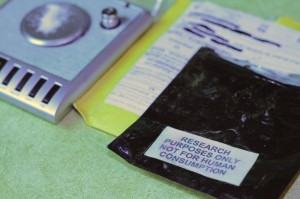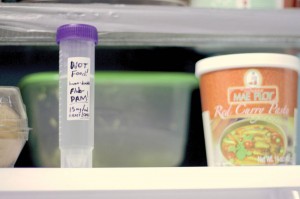
While analog benzos are gaining in popularity, they haven’t really come to the attention of drug experts and addiction counselors –– yet.
“What are some street names of it?” one expert asked.
Good question. They don’t have street names. Not yet, anyway. Which is a good indicator that they have yet to find their ways onto the streets. Online is another story. There, they go by names like etizolam, diclazepam, flubromazepam, flubromazolam, clonozolam, and other words that, like any benzo, end in “lam” or “pam.” Most of them are compounds that were developed by pharmaceutical companies in the early 1960s, when hundreds of benzodiazepine compounds were synthesized, studied, and ultimately tossed aside after diazepam (Valium) was crowned the winner.
The formulas for the losers are still around, in patents that long ago became public domain.
Despite the antiquity of these formulas, the freshly unearthed and synthesized results are still too new for any rehabs in the area to be familiar with them. That will change by this time next year. These drugs will be all over the news. They’ll all be lumped together under a name that their users have never heard of like “cracklers” or “rattlesnakes” or something, because it’s important, for some reason, for the names to be senseless.
Lisa Hinson hasn’t heard anyone “admit to using synthetic benzos,” she said. And, of all people, she would know. Hinson has worked in the drug rehabilitation field for more than 20 years, and she is currently serving as a clinical representative at Starlite Recovery Center in Center Point, Texas, about a four-hour drive south. She lives in North Texas, though, working also at CRC Health Group, a national treatment provider.
She hasn’t come across analog benzos, she said, “just other synthetics — synthetic stimulants, derivatives of bath salts … . Are you familiar with ‘gravel’ and those things?”
“The stuff that’s also called ‘flakka’?”
“Yes, they’re the same,” she said. “They’re used interchangeably. For the bulk of the clients that I deal with, that’s what is still pretty popular out there.”
Flakka and gravel refer to a synthetic stimulant known as a-PVP. A string of bizarre incidences in Florida a couple of years ago, all probably attributable to the paranoid delirium experienced after four days without sleep, resulted in a temporary federal ban on a-PVP.
“The few times that I’ve heard of people using analog benzos, they’ve been admitted to [psychiatric facilities] before they’ve come to a standard, residential treatment center,” she added.
What this means is that, basically, people are taking way more of, and withdrawing way harder from, analog benzos.
******

The Grapevine Valley Hope Rehabilitation Center has seen a few cases in the last several months, said Christine Rodriguez, a licensed chemical dependency counselor who has been working at Valley Hope since 2003.
And these aren’t just any cases.
“They’re coming in sicker than the regular benzo withdrawals,” she said. “They’re just having completely different withdrawal symptoms.”
This is likely attributed to the low cost of benzo analogs, making it possible for a relatively massive quantity to be ingested daily. The withdrawal symptoms aren’t actually different from “regular” benzo withdrawals, but they’re intensified to such an extent that they’re unrecognizable by comparison.
What Rodriguez is seeing is the equivalent of a daily intake of about 400 milligrams of Xanax.
It wasn’t surprising to hear. There’s the old street adage: “The drugs that are the cheapest dig the holes that are the deepest.” That’s an ominous theory in this context, because compared to most drugs that can ruin your life, benzo analogs seem practically free. You could pay around $50 for enough of them, if taken daily, to suffer from withdrawal symptoms when your stash runs out. Sure, daily benzo use is irresponsible, but would anyone expect to experience withdrawals from $50 worth of drugs?
In fact, are most people even aware that benzo withdrawal exists and that it’s extremely dangerous? Sure, there are Xanax addicts who know this, but it’s not common knowledge that benzos — analog or otherwise — are more dangerous to withdrawal from than heroin. It’s not something that’s been publicized much. Benzo withdrawals are dangerous for the same reasons that alcohol withdrawal is: They bind to various GABA receptor sites in the brain, which triggers the release of GABA, an inhibitory neurotransmitter that’s used by about a third of the central nervous system’s synapses. In extremely simplified terms: The GABA increase causes sedation and a feeling of confidence and well-being. When GABA’s triggered too often by external factors, like daily benzo or alcohol use, the GABA receptors learn to rely on those external factors and start forgetting how to function on their own. When the external factors go away, the GABA receptors forget to release a proper amount of GABA. For the mind and body, this means, sweating, shaking, heart palpitations, hallucinations, panic attacks, sensations of electric shocks, depersonalization, intense insomnia, and, well, just think of everything that feels bad in any way whatsoever, and it’s probably on the list of benzo/alcohol withdrawals. At their worst, they can cause seizures and/or death.
Would the average 18-year-old fully comprehend the risks of daily benzodiazepine use and of upping his or her dosage every few days? Probably not, and according to Rodriguez, they’re the demographic that’s the most vulnerable.
“The patients who have come in are younger,” Rodriguez said, “and it’s the parents who recognize the severe difference of what’s going on with their 19- or 20-year -old.”
She recalled a recent patient but not the name of the analog drug that had brought him to her doorstep.
She had to turn him away.
“We just don’t have the ability to take care of the psychiatric problems that were happening along with the detox, as well as the physical problems,” she said.
She had heard of dealers selling one of these analogs on the streets, pitching it as “more like a Valium,” but the name of it was escaping her at the moment.
I made a guess. “Is it etizolam, by chance?”
“It was etizolam,” she said, and it later clicked with her that, yes, etizolam was also the drug used by that delirious patient, the one so far gone that Valley Hope was forced to send him somewhere equipped with things like IVs and whatever tools are used, after a particularly nasty seizure, to dislodge someone’s tongue from his throat.
On the patient numbers, she said “about five, maybe more, in the last several months.”
As for the nature of the trend: “It’s showing up here and there.”
They weren’t big numbers, but they were coming from a brand new set of drugs and hinted at a much larger potential problem.
“We’ve been seeing a lot of the K2, a lot of the bath salts, things like that,” Rodriguez said. “As for the benzo analogs, not as much. But I definitely think that it’s going to be up on the rise soon.”
******











